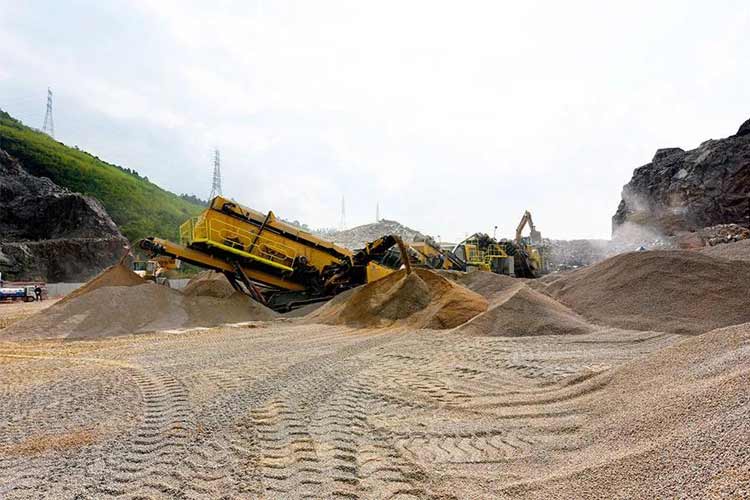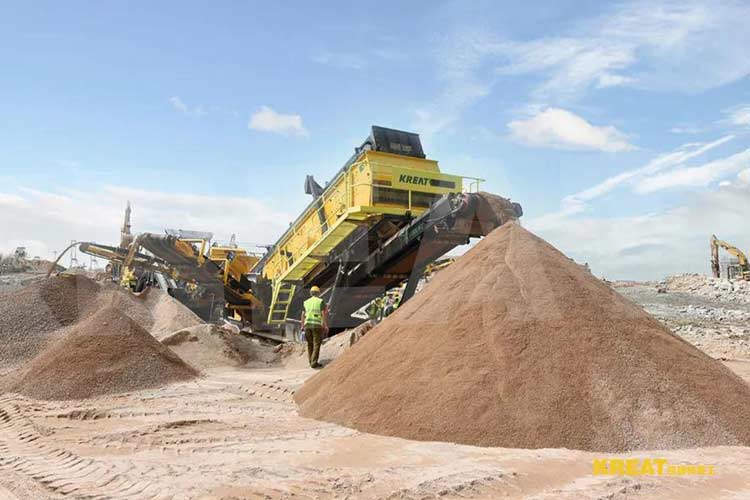

Company News 2023-06-13
Kreat Crawler Mobile Screening Station KS-1303 (hereinafter referred to as KS-13033) is a high-efficiency screening equipment that uses track driven walking mode, advanced technology, and complete functions. Due to its optimized unique dynamic design and intelligent process control system, it has a strong, durable, stable, and reliable high-efficiency screening ability, making it an ideal choice among numerous independent screening or multi-stage crushing screening process flows.

KS-1303 Product Introduction
The working host of Kreat KS-1303 is a circular vibrating screen. It can achieve heavy-duty, intermediate, and fine screening, mainly used in quarries, mines, construction demolition debris treatment, surface soil treatment, material recycling, gravel screening, coal mine and aggregate screening and other engineering projects. It can also be used for material grading in industries such as mineral processing, power generation, and chemical engineering.
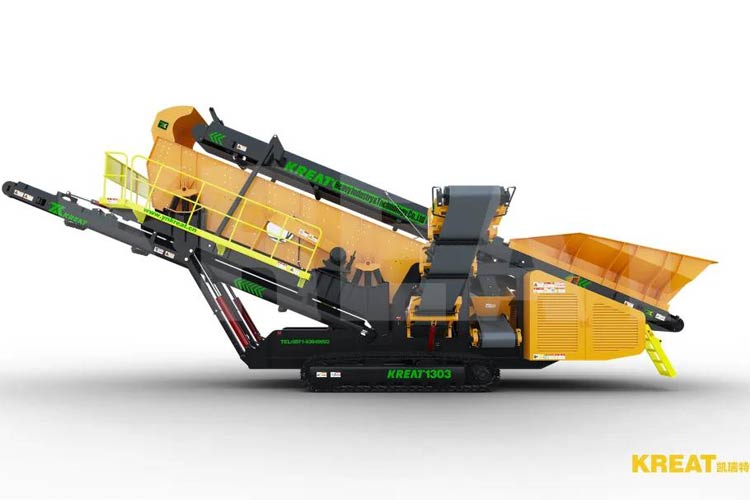
The track trolley of Kreat KS-1303 is driven by hydraulic pressure, and the mutual conversion between its auxiliary frame, various screen discharge machines, and the transportation position (storage position) to the working position is driven by hydraulic cylinders, while the hydraulic system is powered by a diesel engine; The circular vibrating screen is driven by an electric motor; The feeding machine and each discharge machine are driven by electric rollers.
Main parameters
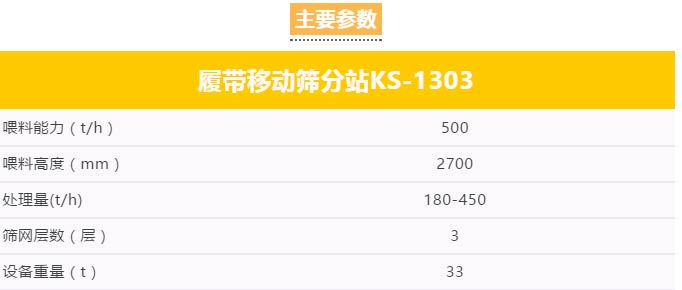
Working principle

Kreat KS-1303 working host YK type circular vibrating screen implements the mechanical industry standard of the China JB/T 6388-2004 YKR type circular vibrating screen. The screen can be equipped with metal and rubber screens. The type of screen surface and screen hole size can be selected and determined by the user at the time of ordering. There are three layers of screen surfaces, supported by spring supports and driven by motor drive belts.
A circular vibrating screen is a screening equipment for a single mass forced vibration system with movable parts such as a sieve box and an exciter as the mass, metal spiral springs or rubber springs as the elastic components, and an exciter as the excitation mechanism.

The motor drives the exciter through a V-belt drive, and the eccentric block rotates at a high speed to generate strong centrifugal force, causing the material to continuously roll in an approximate elliptical shape on the circular vibrating screen. Through continuous flipping and loosening, the fine particles have the opportunity to move towards the lower part of the material layer and be discharged through the sieve hole. Materials with a particle size larger than the sieve hole can jump out of the sieve and enter the finished material conveyor, effectively avoiding the blockage of the sieve hole. And through such repeated movements, the grading and screening process of granularity was completed.
Advantages and characteristics of tracked mobile screening station products
1. Efficient screening: Designed with dynamic optimization and a complete screening system, it does not require on-site installation and debugging, and can be quickly put into production;
2. Meet diversified screening needs: optional plate feeding system to achieve screening efficiency for special materials;
3. The three-layer design has a wide range of uses: the screening machine has a three-layer screen design, which can screen up to 4 practical end products, and each finished material conveyor belt can be hydraulically folded to achieve complete machine transportation;
4. Convenient maintenance and transportation: The vibrating screen can be lifted and lowered by hydraulic pressure, making it easy to repair and replace the screen mesh;
5. Can achieve rapid transition operations: using intelligent wireless remote control devices, with good on-site mobility and adaptability to various complex construction environments such as mountains and wetlands.
Daily maintenance and upkeep of main components of KS-1303

Maintenance cycle of vibrating screen
Every day
① Ensure that the screened material is uniformly fed into the machine, and if possible, ensure that it is fed exactly within its entire width range (check during machine operation);
② Pay attention to any abnormal sounds;
③ Ensure that the screening station components are not contaminated or blocked;
④ Ensure that the screening station components are properly fastened (especially after replacement);
⑤ Check the condition of all screening components and replace them if necessary;
⑥ Check if all safety labels are in good condition.

weekly
① Check the condition of all springs;
② Check if there is any accumulated material under the machine, and if there is any material, it should be cleaned in a timely manner;;
③ Check the fasteners;
④ Check the condition of the wear-resistant gasket and protective components.
Monthly
① Check the belt tension to ensure that there is no grease or oil on it. In addition, check if there is any accumulation of foreign objects in the groove, and if there are any foreign objects, they should be cleaned in a timely manner;
② Check the condition of the casing;
③ Check the bearing temperature (should not exceed 95 ℃);
④ Clean and visually inspect the balance weight;
⑤ Run the machine for a short period of time to avoid bearing corrosion;
⑥ Check the condition of the rubber protection device.
Every season
① Use a stroke card to check the strokes of all four corners;
② Check for any machine damage or loose components;
③ Check the condition of all protective devices;
④ Check the condition of the feeding and unloading chutes;
⑤ Check the temperature and current consumption (amperes) of the motor;
⑥ Check the tightness of all screws (including the screws securing the mechanical device, pulley, and balance weight).
Maintenance cycle of feeding and discharging machines
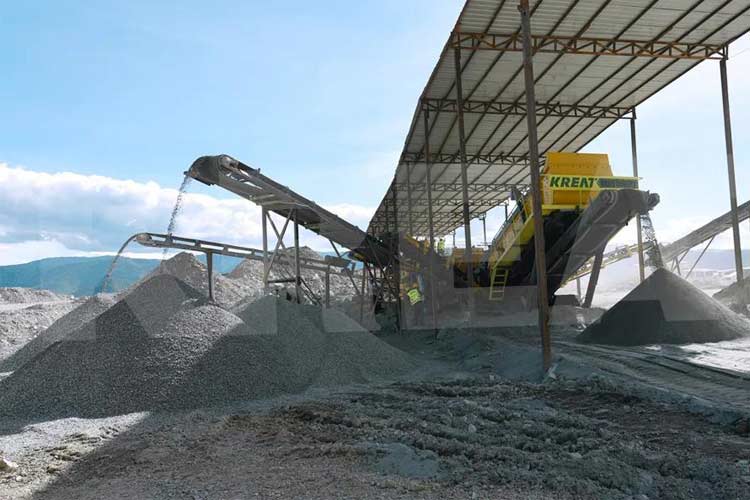
Every day
① Check the cleanliness of the machine appearance;
② Check the surface of the roller and drum, and if there are adhesive materials, they should be cleaned in a timely manner;
③ Check the surface wear of the conveyor belt, and if there is peeling or damage, replace it in a timely manner;
④ Check the tension of the conveyor belt and check if there is any slipping in the working state;
⑤ Check the working status of the conveyor belt for any deviation and adjust it;
⑥ Check for any material leakage and accumulation during work;
⑦ Check the working condition of all cleaners and make corresponding adjustments;
⑧ Check if all safety labels are in good condition.
Weekly
① Check the condition of the feeding and unloading chutes;
② Check the temperature and current consumption (amperes) of the motor;
③ Check the condition of each material baffle.
Monthly
① Check the bearing temperature (should not exceed 95 ℃);
② Check the gearbox and lubricating oil level, and replace the lubricating oil once according to regulations;
③ Run the machine for a short period of time to avoid bearing corrosion.
Every season
① Check the condition of the rubber protection device;
② Check for damaged or loose components;
③ Check the condition of all protective devices;
④ Check the condition of the rack;
⑤ Check the tightness of all bolts.
Construction case of KS-1303 crawler mobile screening station
